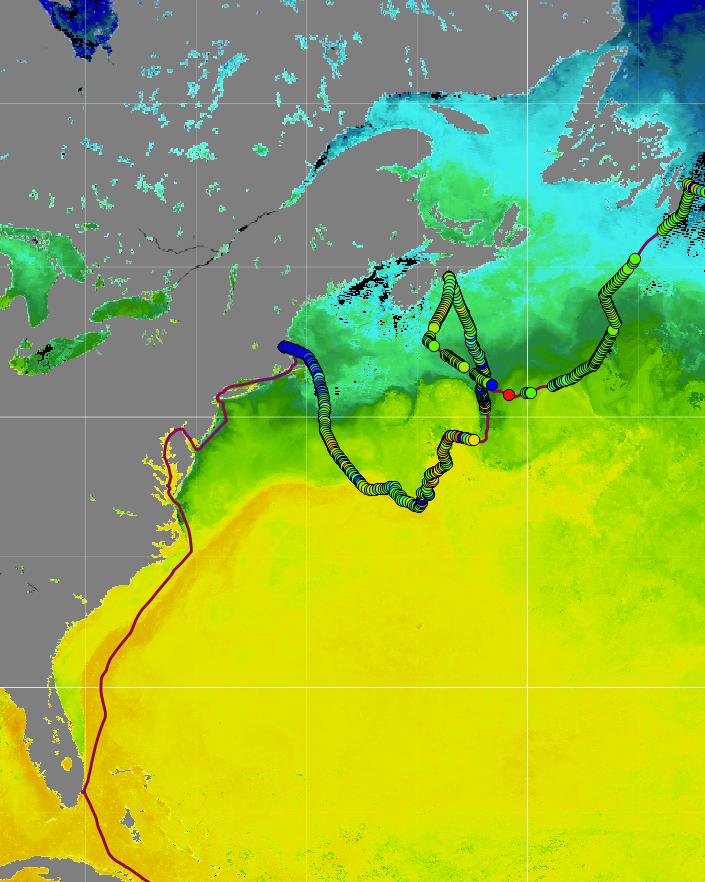Exploring ocean waters to characterize atmospheric aerosols

Representation of the temperatures on the surface of the Atlantic Ocean near the north-american coast. In blue, the colder bodies of water where biological activity is more important. In yellow, warmer bodies of water where biological activity is weaker. Along the PlanetSolar itinerary, the colored dots represent the concentration of organic aerosols, from blue (light concentration) to red (strong concentration). Credit: ©UNIGE
Aerosols are collections of fine particles, either biological or of other types, in suspension in a gaseous medium. They play a major role in cloud formation and therefore have a strong impact on climate models. They are however extremely hard to study due to the small size and immense variety of their constituent particles.
But researchers from the University of Geneva (UNIGE), Switzerland, members of the PlanetSolar Deepwater expedition, have now succeeded in linking the composition of marine biological aerosols — and therefore their influence on the climate — to that of bodies of water under them within the Atlantic Ocean, thereby paving the way to an indirect study of these aerosols through water analysis. This study, which has been published in Scientific Reports, will contribute to making climate models more accurate.
Aerosols are fine particles in suspension in the air. Over the oceans, some contain organic or biological ingredients (bacteria, degradation products of microscopic algae) which come from sea spray, others are transported in the air (mineral dust, smoke).
They serve as seeds for forming clouds and also reflect light. Their role is extremely important for modelling clouds, and therefore for the climate in general. But due to the small size of the particles and their large quantity, it's difficult to accurately study them. So researchers at the University of Geneva (UNIGE) asked themselves if it would be possible to characterize biological aerosols through the composition of the water whence they come.
“To answer this question, we needed two tools,” explains Jérôme Kasparian, Professor in the Department of Applied Physics at the UNIGE Science Faculty. “The first is a detector of fluorescence which we designed, called Biobox, and which enables us to analyse aerosol particles one by one.
The spectrum gives us information on their composition and distinguishes the organic particles, which are fluorescent, from the other particles. Then we needed PlanetSolar.” Indeed this research could only be undertaken over a long time period of time without any disturbances of water and air. Only PlanetSolar, a solar boat that navigated remains at sea for three months and produces no emissions, could make it possible.
During the expedition, scientists carried out analysis of the salinity, temperature, dissolved oxygen and the microalgae contained in the various bodies of water in the Atlantic, and then compared this data with that obtained by the Biobox. “And we found that they matched!” exclaims Jérôme Kasparian. The physicists discovered that biological aerosols are related to the temperature and salinity of the sea.
According to previous criteria, water creates large bodies that don't inter-mix, which allows them to be differentiated. Thus, when the characteristics of a water mass were favourable for reproduction of microalgae, researchers noticed that after a certain amount of time, the aerosols detected above this same water mass contained more biological particles. The biological fraction of aerosols is therefore linked to the history of biological activity of bodies of water close to the surface.
“Provided that this is also valid in oceans and seas other than the Atlantic, our research location, our results would allow us to estimate biological aerosols by directly studying the bodies of water, which would simplify aerosol caracterization and make climate models more accurate,” adds Kasparian. Difficult to study directly, aerosols are now being studied via the sea, which, unlike aerosols, can easily be analysed by satellites.
Media Contact
All latest news from the category: Earth Sciences
Earth Sciences (also referred to as Geosciences), which deals with basic issues surrounding our planet, plays a vital role in the area of energy and raw materials supply.
Earth Sciences comprises subjects such as geology, geography, geological informatics, paleontology, mineralogy, petrography, crystallography, geophysics, geodesy, glaciology, cartography, photogrammetry, meteorology and seismology, early-warning systems, earthquake research and polar research.
Newest articles

First-of-its-kind study uses remote sensing to monitor plastic debris in rivers and lakes
Remote sensing creates a cost-effective solution to monitoring plastic pollution. A first-of-its-kind study from researchers at the University of Minnesota Twin Cities shows how remote sensing can help monitor and…

Laser-based artificial neuron mimics nerve cell functions at lightning speed
With a processing speed a billion times faster than nature, chip-based laser neuron could help advance AI tasks such as pattern recognition and sequence prediction. Researchers have developed a laser-based…

Optimising the processing of plastic waste
Just one look in the yellow bin reveals a colourful jumble of different types of plastic. However, the purer and more uniform plastic waste is, the easier it is to…



